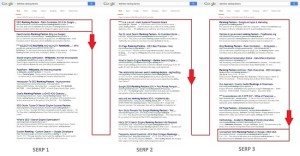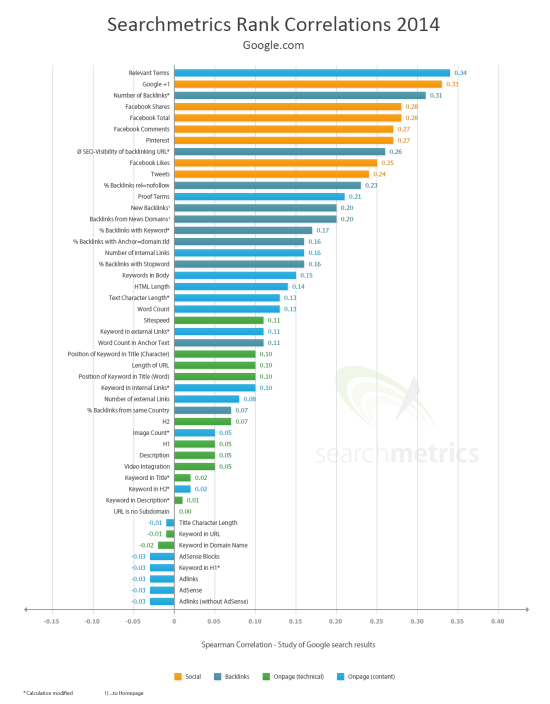It’s here! This fall season’s most important piece of SEO reading. This year’s report, available as a PDF to download, took a little longer than usual to prepare, because it’s more than a study. It’s an extensive analysis of trends and the status quo in SEO today, and we are publishing it as a White Paper. It runs to 100 pages, has easy-to-follow chapter headings, and covers what we think are the most important factors in SEO 2014.
We have taken on board all the feedback and critiques that we received from previous studies, and incorporated these into the White Paper. It’s now more than a White Paper, with a scope and an academic approach that has produced the 2014 fall season’s SEO survival guide for SEOs and online marketers in the field.
White Paper Download:
Rank Correlations And SEO Ranking Factors Google U.S. 2014
We have greatly expanded the number of features researched to analyze and evaluate what differentiates the higher-ranking sites in the top positions in Google from those that don’t quite make it.
This year we have put more weight on average values of the features, as these produce a more accurate analysis in addition to the respective correlation values. In doing so, we want to prevent potential causal inferences, the tempting but often incorrect ‘gut feel’ analysis that we at Searchmetrics avoid at all costs.
That’s why we focus on these two approaches:
- Correlation of Top 30 = Differences between URLs within SERP 1 to 3
- Averages of Top 10 = “Similarities” of top sites ranking on SERP 1
The Right Interpretation: Correlations, Averages And Ranking Factors
As an extra this year, to be as transparent as possible in explaining our approach  and the background to this study, we have a separate section explaining exactly how we define the term “Ranking Factor”: What is it? How are our correlations calculated? What conclusions can we draw from these calculations, and what are the actual average figures we analyzed for the features we investigated? All of this can be found here: What is a Ranking Factor?
and the background to this study, we have a separate section explaining exactly how we define the term “Ranking Factor”: What is it? How are our correlations calculated? What conclusions can we draw from these calculations, and what are the actual average figures we analyzed for the features we investigated? All of this can be found here: What is a Ranking Factor?
It’s well worth looking at the examples that illustrate our workings, the explanation of the data we used and our analytical approach – the backbone of our findings.
Features, Results And Evaluations for 2014
 We have analyzed the top 30 Google rankings for 10,000 keywords – approximately 300,000 URLs – with a focus on information-oriented search terms. Correlations relate to the measurable differences between individual search results, and this year we have included these in the bar chart below, which shows correlation values for the most interesting features of 2014:
We have analyzed the top 30 Google rankings for 10,000 keywords – approximately 300,000 URLs – with a focus on information-oriented search terms. Correlations relate to the measurable differences between individual search results, and this year we have included these in the bar chart below, which shows correlation values for the most interesting features of 2014:
We have, of course, examined factors from previous studies, but this year we have included additional analysis of many new features, particularly in the areas of Content, Backlinks and Brands.
New Features: Content, Backlink And Brand Sections
Some of the new features are intrinsic to the Content Optimization area of the Searchmetrics Suite, and are based on co-occurrence evaluations of keywords and relevant terms. For the first time we have included user features such as Bounce Rate measured on a keyword basis, which provides information to correlate user signals with rankings. This data came from thousands of Google Webmaster Tools accounts and was anonymized for the analysis.
White Paper Download:
Rank Correlations And SEO Ranking Factors Google U.S. 2014
I highly recommend downloading and reading our white paper, the “SEO Must-Read 2014”.
By the way, we’ve even had a factor dealing with “http vs. https” within this year’s pool of features to be analyzed, but we have decided not to take it into the study. Even after updating the analysis there seems to be no relation between the search results and https evident (yet?). I have already written something about it here: HTTPS vs. HTTP – Analysis: Do secure sites really get higher rankings?. We will keep you updated.
2014 – Main Developments And Trends At A Glance:
For the impatient among you, here are the notable findings of the 2014 White Paper, including rank-correlation analyses, averages and Ranking Factors in a nutshell:
1 Content
- There is a measurable correlation between the quality of content and rankings. This is demonstrated by, among others, the analysis of two new features based primarily on word co-occurrence analysis: Proof and Relevant Terms.
- The length of content continues to increase.
- A good internal linking structure is an important factor, and probably the most underrated SEO measure.
2 Onpage Technical SEO
- Onpage, the keyword remains an important part of the overall concept for SEO, often represented by a balanced presence in Title, Description, Body copy, H1, H2, etc. Needless to say, that keyword stuffing should still be avoided. However, there is a definite trend towards developing keywords to topics to generate holistic content.
- Site load speed is a very
 important performance factor.
important performance factor. - Good site architecture is the beginning and end of effective SEO.
3 Backlinks
- The quantity and especially the quality of backlinks remains important.
- The number of keyword backlinks continues to decrease, even if the correlation increases.
- Backlink features for Brands (Point 6 below) appear to work differently to the rest of the URLs in SERPs.
4 Social Signals
- There were minor changes to the previous year, with Social signals correlating slightly less with good rankings than last year.
- Average values rose slightly.
5 NEW* User Signals
- Both the click-through rate and the time-on-site are considerably higher in better ranking sites – this may appear obvious, but average values determined over many URLs can be used as a benchmark for your own optimization.
- The bounce rate is lower for top-ranking URLs.
6 Improved* Brand Factor
- There seem to be special consideration for big brands.
- The Brand Factor and its definition have been revised this year, to show the increasing complexity of its influence and quality.
Conclusion: SEO In 2014 And Beyond – What Are The Takeaways?
There are areas where Google seems to have found a good balance. However, there are many more areas where constant revision and development of features is taking place, with the treatment of Brands constantly maturing. The real focus, however, is still page content, where relevance is key. In all areas, the trend towards a natural structure is clear. Just as the quality of the link profile is better when designed, the overall content structure is better when it is easily understood and holistic.
Here’s the download link one more time:
White Paper Download:
Rank Correlations And SEO Ranking Factors Google U.S. 2014
SEO is becoming more and more natural, with the focus moving towards Search Experience Optimization (= the user) in the future, and with the technical aspects of site optimization remaining crucial. Let us have your thoughts on this year’s evaluation? As always, I look forward to your feedback and suggestions!



